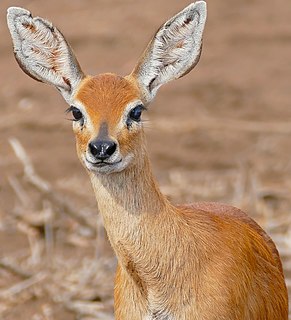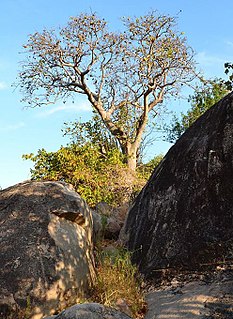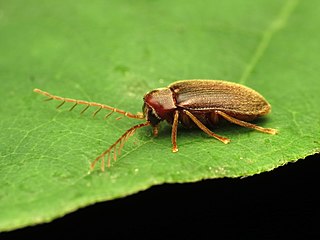
Sterculia is a genus of flowering plants in the mallow family, Malvaceae: subfamily Sterculioideae. Members of the genus are colloquially known as tropical chestnuts. The scientific name is taken from Sterculius of Roman mythology, who was the god of manure; this is in reference to the unpleasant aroma of the flowers of this genus. Sterculia may be monoecious or dioecious, and flowers unisexual or bisexual.

The triangle keelback is a species of snake found in Brunei Darussalam, Burma (Myanmar), Cambodia, India, Indonesia (Nias, Mentawai, Sumatra, Laos, Malaysia, Singapore, Thailand, and Vietnam.

Raphicerus is a genus of small antelopes of the tribe Neotragini.

Scaphium affine is a tree species in the family Malvaceae, subfamily Sterculioideae. It is native to mainland Southeast Asia and no subspecies are listed in the Catalogue of Life.

Woodfordia fruticosa is a species of plant in the family Lythraceae.

Helicteres is a genus of flowering plants in the family Malvaceae.

Sterculia urens is a species of plant in the family Malvaceae. It is native to India and has been introduced into Burma. A small to medium-sized tree with a pale-coloured trunk, it is commonly known as the भुत्या in Marathi, kulu, Indian tragacanth, gum karaya, katira, sterculia gum or kateera gum. The specific name urens refers to the stinging hairs present on the flowers.
Sterculia hypochroa is a tree species described by Pierre, belonging to the genus Sterculia and the family Malvaceae. No subspecies are listed in the Catalogue of Life. These trees are found in Vietnam, where they are known as trôm quạt.

Protium serratum is a small-medium tree species in the genus Protium and the family Burseraceae. The Catalogue of Life does not record any subspecies.

Pothos scandens is a climbing tropical forest plant in the family Araceae. It is the type species of the genus Pothos. No subspecies are recorded in the Catalogue of Life.
Sterculia cochinchinensis is a tree species belonging to the genus Sterculia in the family Malvaceae. The name is unresolved according to The Plant List. This species is found in Laos and Vietnam and there are no subspecies listed in the Catalogue of Life.

Sterculia lanceolata is a tree species, belonging to the genus Sterculia and the family Malvaceae. The species can be found in southern China and Vietnam.
Sterculia stigmarota is a plant, belonging to the genus Sterculia and the family Malvaceae. This species is found only in southern Vietnam and there are no subspecies listed in the Catalogue of Life.

Sterculia africana is a deciduous tree, belonging to the genus Sterculia and the family Malvaceae. The species is sometimes called the "mopopaja tree". It is distributed throughout Northeast Africa to Arabia.

Sterculia lanceifolia is a bush/tree species belonging to the genus Sterculia in the family Malvaceae. This species is found in Bangladesh, NE India, China and Indo-China and there are no subspecies listed in the Catalogue of Life.
Sphaerosacme is a monotypic genus of trees in the family Meliaceae. The sole species is Sphaerosacme decandra. No subspecies are listed in the Catalogue of Life. Its distribution includes: Nepal, North Andamans, Bhutan, India and Myanmar [Burma] (Kachin).
Anisoptera aurea is a tree species in the family Dipterocarpaceae. This Asian species has been recorded from: the Philippines (Luzon), peninsular Malaysia (Penang), Sumatra, and Myanmar [Burma] (Taninthayi). No subspecies are listed in the Catalogue of Life.

Ptilodactylidae is a family of toe winged beetles in the order Coleoptera. There are about 6 genera and 15 described species of North American Ptilodactylidae.

Throscidae is a family of small false click beetles in the order Coleoptera. In North America, there are 3 genera and 20 described species.
Etlingera sulfurea is a monocotyledonous plant species that was first described by Richard Neville Parker, and got its current name from Rosemary Margaret Smith. Etlingera sulfurea is part of the genus Etlingera and the family Zingiberaceae.













